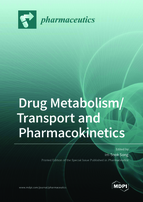Drug Metabolism/Transport and Pharmacokinetics
A special issue of Pharmaceutics (ISSN 1999-4923). This special issue belongs to the section "Pharmacokinetics and Pharmacodynamics".
Deadline for manuscript submissions: closed (31 March 2020) | Viewed by 54363
Special Issue Editor
Interests: pharmacokinetic drug–drug interaction; pharmacokinetic herb–drug interaction; drug-metabolizing enzymes and transporters; pharmacokinetic/pharmacodynamics in drug development; oral bioavailability
Special Issues, Collections and Topics in MDPI journals
Special Issue Information
Dear Colleagues,
Clinically important phase I and II metabolizing enzymes and transporters from two major superfamilies, ABC (ATP binding cassette) and SLC (Solute carrier) transporters, are designated and the pivotal roles of drug metabolizing enzymes and drug transporters in the pharmacokinetics, pharmacogenomics, and drug-drug interactions have been recognized. Therefore, researchers and regulatory agencies have made an effort to understand the pharmacokinetics, pharmacogenomics, and drug–drug interactions with respect to mechanistic changes in these drug metabolizing enzymes and transporters. With a trend of polypills and increased use of medicinal food, concurrent administration of herbal drugs can cause serious adverse reactions with substrate drugs of metabolizing enzymes and transporters by the potential for the inhibition or induction of their activities. For this, the prediction and evaluation of the contribution of drug metabolizing enzymes and transporters to the pharmacokinetics and drug–drug interaction potential of drugs or drug candidates are important in clinics and in the drug development process.
This Special Issue will highlight pharmacokinetics/drug–drug interactions and mechanistic understanding in relation to the drug metabolizing enzymes and drug transporters.
Prof. Dr. Im-Sook Song
Guest Editor
Manuscript Submission Information
Manuscripts should be submitted online at www.mdpi.com by registering and logging in to this website. Once you are registered, click here to go to the submission form. Manuscripts can be submitted until the deadline. All submissions that pass pre-check are peer-reviewed. Accepted papers will be published continuously in the journal (as soon as accepted) and will be listed together on the special issue website. Research articles, review articles as well as short communications are invited. For planned papers, a title and short abstract (about 100 words) can be sent to the Editorial Office for announcement on this website.
Submitted manuscripts should not have been published previously, nor be under consideration for publication elsewhere (except conference proceedings papers). All manuscripts are thoroughly refereed through a single-blind peer-review process. A guide for authors and other relevant information for submission of manuscripts is available on the Instructions for Authors page. Pharmaceutics is an international peer-reviewed open access monthly journal published by MDPI.
Please visit the Instructions for Authors page before submitting a manuscript. The Article Processing Charge (APC) for publication in this open access journal is 2900 CHF (Swiss Francs). Submitted papers should be well formatted and use good English. Authors may use MDPI's English editing service prior to publication or during author revisions.
Keywords
- pharmacokinetics
- phase I and II metabolizing enzymes
- drug transporters
- drug–drug interaction
- herb–drug interaction
- enzyme inhibition and induction







